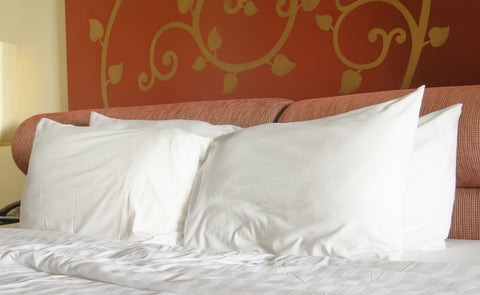You spend a third of every day with your head on that cushion, so how to clean a memory foam pillow without ruining it (step-by-step) isn’t just trivia—it’s the key to waking up pain-free and allergy-free. By the end of this guide, you’ll know exactly what to do, how often to do it, and what rookie mistakes to avoid.
Why Memory Foam Needs Special Care
-
Sensitivity to moisture: Unlike down or polyester, memory foam soaks up water like a sponge, making mold a real risk.
-
Dense structure: Dirt, oils, and dust mites burrow in deeper, so surface wipes alone won’t cut it.
-
Heat-responsive cells: Hot water or harsh detergents can break down the foam and flatten its contouring magic.
Understanding these quirks sets you up for the right cleaning strategy rather than a one-size-fits-all approach.
Time for TLC: Signs Your Pillow Is Begging for a Wash
-
Lingering odor even after a pillowcase change.
-
Yellow or gray patches that don’t disappear with spot cleaning.
-
Increased sneezing or congestion when you lie down.
-
Loss of bounce-back—the foam feels sluggish or clumpy.
If any box is checked, it’s cleaning day.
Quick Refresh vs. Deep Clean: Choose Your Route
|
Situation |
Best Method |
Frequency |
|
Light sweat, minimal stains |
Surface refresh with vacuum + baking-soda deodorizing |
Every 2 weeks |
|
Noticeable odor or small spill |
Targeted spot clean |
As needed |
|
Stains, dust-mite worries, or 3-month interval |
Full deep clean (steps below) |
Every 3 – 4 months |
Step-by-Step: Deep-Clean Your Memory Foam Pillow Without Ruining It
Step 1: Assemble Your Cleaning Kit
-
Large basin or bathtub
-
Lukewarm water (never hot)
-
Gentle, dye-free liquid detergent (1 tbsp per gallon)
-
White vinegar (optional deodorizer, ½ cup)
-
Two clean towels
-
Flat drying rack or well-ventilated surface
Step 2: Pre-Vacuum and Deodorize
-
Lay the pillow flat.
-
Vacuum both sides using the upholstery attachment—this lifts away hair and dust.
-
Sprinkle a light coat of baking soda, wait 15 minutes, and vacuum again to neutralize odors.
Step 3: Draw a Gentle Bath
Fill the basin with enough lukewarm water to submerge the pillow halfway. Swirl in detergent until suds appear, then add vinegar if odor is strong.
Step 4: Submerge and Squeeze—Never Twist
-
Lower the pillow slowly to prevent trapping air bubbles.
-
Use gentle presses—think of squeezing a sponge—so soapy water moves through the foam.
-
Repeat for 5 minutes. Do not wring, twist, or fold; those motions tear foam cells.
Step 5: Rinse Thoroughly
Drain the basin, refill with clean lukewarm water, and press the pillow repeatedly until the water runs clear. Residual soap left inside will stiffen the foam and shorten its lifespan.
Step 6: Towel-Press to Remove Excess Water
Lay the pillow flat on a folded towel, place another towel on top, and press. The goal is to wick away surface moisture while keeping the pillow’s shape intact.
Step 7: Air-Dry Correctly
-
Place the pillow on a mesh drying rack or propped on its edge in a breezy, shaded area.
-
Flip every 2 hours to speed evaporation.
-
Avoid direct sunlight or tumble dryers; high heat melts foam cells and creates permanent lumps.
-
Expect 24 – 48 hours to fully dry—patience equals preservation.
Keeping It Clean: Ongoing Maintenance Tips
-
Use a breathable pillow protector. It blocks sweat and oils while letting air flow.
-
Wash pillowcases weekly. Fresh linens reduce bacteria reaching the foam.
-
Rotate the pillow 180° each month to distribute pressure evenly.
-
Let it breathe each morning: pull back covers for 10 minutes to release trapped moisture.
-
Sun-air occasionally (20 minutes in indirect light) for natural deodorizing without UV damage.
Troubleshooting FAQs
Can you machine-wash a memory foam pillow?
No. Agitation and spin cycles twist the foam beyond recovery, leading to cracks or flattening.
What about tumble-dry on low heat?
Still risky. Even “low” can exceed the safe temperature threshold. Air-drying preserves loft and support.
How do you remove stubborn yellow sweat stains?
After the standard wash, make a paste of baking soda and a few drops of water. Spread over the stain, wait 30 minutes, rinse gently, and repeat drying steps.
Is fabric softener safe?
Skip it. Softeners leave a slick residue, clogging the foam’s open cells and limiting breathability.
How often should you replace the pillow altogether?
With proper care, expect 2 – 3 years of peak performance. If it no longer rebounds or cleaning can’t revive freshness, it’s time for a new one.
Rest Easy: Clean Pillow, Clear Mind
Now you’ve mastered how to clean a memory foam pillow without ruining it (step-by-step), your nightly comfort—and spinal alignment—are back on track. Stick to the schedule, respect the foam’s delicate nature, and you’ll breathe easier, sleep deeper, and wake up ready to conquer the day. Sweet dreams!



